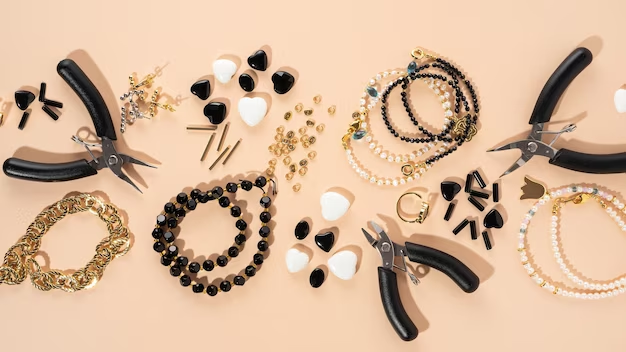In jewellery, the artistry behind earring design extends far beyond the mere selection of gems and metals. It dives deep into the world of earring components, the essential yet often understated elements that form the skeleton of earring designs. For jewellers across the world, these findings are valuable pieces and pivotal elements of innovation and style. This blog unfolds the layers of earring findings, showcasing their transformative power in the hands of creative jewellers.
The Essence of Earring Findings
At the core of any earring design lies its findings—a term encompassing hooks, posts, hoops, clasps, and more. These components ensure comfort and security for the wearer, but their importance stretches beyond functionality. They can be masterfully integrated into the design, contributing significantly to the earring’s aesthetic appeal and making it a vital part of the jewellery’s narrative.
Choosing the Right Components
Selecting the appropriate findings is a critical step in the design process. Various findings allow jewellers to tailor their designs according to aesthetic preferences and functionality. From the secure closure of lever-back hooks, ideal for heavier designs, to the simplistic elegance of fish hooks, suitable for lighter pieces, the choice of findings can significantly influence the earrings’ look and wearability.
Innovation in Material and Design
The evolution of materials for these components has been significant, with options ranging from traditional gold and silver to brass and hypoallergenic alternatives like titanium. This diversity allows jewellers to explore a broader spectrum of design possibilities, blending different materials for contrast or thematic harmony, thus elevating the role of findings from mere connectors to central design elements.
Customisation: A Key to Distinction
Customisation is increasingly becoming a hallmark of distinction in jewellery design. Jewellers are tapping into the demand for personalised jewellery by customising earring findings— embedding gemstones, engraving, or creating unique shapes. This sets their pieces apart and caters to the growing consumer desire for jewellery that reflects personal style and significance.
Embracing Historical Inspirations
Drawing inspiration from the past, modern jewellers revisit historical earring designs, integrating traditional elements with contemporary aesthetics. This blend of old and new is evident in the resurgence of Victorian-style lever-backs or the minimalist reinterpretation of Art Deco geometries. Such inspirations enrich the design process and connect wearers with the timeless beauty of historical jewellery.
The Role of Technology
The advent of technology, mainly 3D printing, has revolutionised earring design and production. It allows for the creation of intricate details and complex structures that were once impossible. This innovation enhances design flexibility and streamlines manufacturing, allowing jewellers to prototype and perfect their designs quickly.
Sustainability: A Growing Concern
Sustainability concerns are reshaping the jewellery industry, with a growing emphasis on eco-friendly materials and ethical sourcing. Jewellers are responding by prioritising recycled materials for their findings and being transparent about their sourcing practices. This shift appeals to environmentally conscious consumers and aligns with the broader movement towards sustainability in fashion.
Educating Consumers
An informed consumer is an empowered one. Jewellers have an opportunity to educate their clients about the significance of this product, highlighting how quality components contribute to the longevity and comfort of the earrings. By sharing this knowledge, jewellers can deepen customer engagement and appreciation for the craftsmanship behind each piece.
Earring findings are the unsung heroes of jewellery design, offering endless possibilities for creative expression. As the industry evolves, jewellers in New Zealand and beyond who embrace these components as integral to their design philosophy will undoubtedly be in charge of innovation. By marrying functionality with aesthetic appeal and by weaving in elements of customisation, historical inspiration, and sustainability, jewellers can elevate their creations from mere accessories to wearable art.

